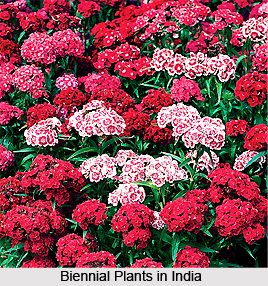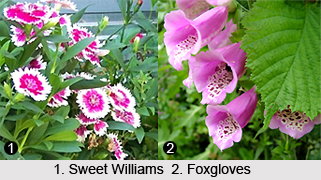The biennial plants in India are the ones that complete their life cycle in two years of growing seasons. During the first growing season they produce leaves, usually a rosette; then in the second growing season, preceded by a cold period, they produce blooms and die.
 For the flower gardener, biennials present the obvious disadvantage of producing only foliage the first year and no blooms. For this reason, new varieties have been developed that produce early bloom. "Foxy" is a variety of foxglove that will bloom in the first year. Biennial seeds can be sown in midsummer to produce plants that develop in the fall, forcing the plant to bloom the next year. Popular biennials are stock and hollyhock. Cultural practices are basically the same as for annuals, except the plants remain two years.
For the flower gardener, biennials present the obvious disadvantage of producing only foliage the first year and no blooms. For this reason, new varieties have been developed that produce early bloom. "Foxy" is a variety of foxglove that will bloom in the first year. Biennial seeds can be sown in midsummer to produce plants that develop in the fall, forcing the plant to bloom the next year. Popular biennials are stock and hollyhock. Cultural practices are basically the same as for annuals, except the plants remain two years.
Biennial plants in India require two growing seasons to fill their life cycle. The first season from seed, they will make leaf growth; they will then over winter and flower in the following year then die. Some plants cultivated as biennials are short-lived perennials, in terms of botany. Sweet william and wallflower are two such instances. They tend to be dug up after flowering simply because they don`t perform well the following year, or become untidy. Some of the better-known biennials in India are Sweet Williams (Dianthus barbatus), Foxgloves (Digitalis purpurea) and Canterbury bells (Campanula medium).
Some perennial plants are called biennials because they flower in the second year. Under extreme climatic conditions, a biennial plant may complete its lifecycle in a very short period of time, such as 3 or 4 months instead of 2 years. This is quite common in vegetable or flower seedlings that were exposed to cold conditions, or vernalised, before they were planted in the soil. This behaviour leads to many normally biennial plants being treated as annuals in some regions of the country. Flowering can be induced in some biennials without vernalisation by application of the plant hormone, gibberellin, but it is rarely done for commercial purposes.
 The Indian biennials produce rosettes of leaves and sometimes the stems the first year, but do not flower until the second and finally they die. If they start their growth early, some biennials flower the year they are sown. This can be a disadvantage, as they will then bloom later than they ordinarily would and at a time when temperatures may be too high for them to last well. This is particularly true of pansies, which produce sturdier plants and flower more prolifically when the weather is cool.
The Indian biennials produce rosettes of leaves and sometimes the stems the first year, but do not flower until the second and finally they die. If they start their growth early, some biennials flower the year they are sown. This can be a disadvantage, as they will then bloom later than they ordinarily would and at a time when temperatures may be too high for them to last well. This is particularly true of pansies, which produce sturdier plants and flower more prolifically when the weather is cool.
Indian biennials are usually sown in late spring or early summer. They are directly sown in the outdoors, in a lightly shaded area. Seeds can be sown in rows or broadcast. One should water the seeds with a fine sprinkler. To save them from drying out, one can cover the seeded area with a piece of burlap topped with a sheet of plastic. The plant has to be inspected daily and the covering should be removed as soon as the first seeds shoot out; otherwise the seedlings will become spindly and die. When the seedlings develop, they are lifted carefully and transplanted to a sunny or lightly shaded nursery bed.
It is essential that biennial plants of India be set in their flowering positions in time to become established -- six to eight weeks before the first hard frost. This includes those that have been raised in a greenhouse or cold frame. Before final planting, one should clear the bed, dig over the soil, and work in well-rotted manure or compost, together with some bone meal or super phosphate at the rate of 3-5 pounds per 100 square feet. Then he should lift the plants from the site to which they have been transplanted, easing them out with a trowel and leaving as many roots as possible attached to each plant. If the soil is very dry, it should be watered first to ease the lifting and to minimize the possibility of root damage. A few evergreen branches can be put over them when the soil freezes in extremely cold areas, and then they can be removed gradually in the spring. Another alternative is to keep the biennial plants in a cold frame during the winter.
Although biennial plants in India are usually transplanted at least once, they can be sown in their permanent positions and later thinned. Beets, Brussels sprouts, cabbage, celery and carrots are some of the biennial plants in India. These plants are some of the most colorful ornamentals of the season.



















